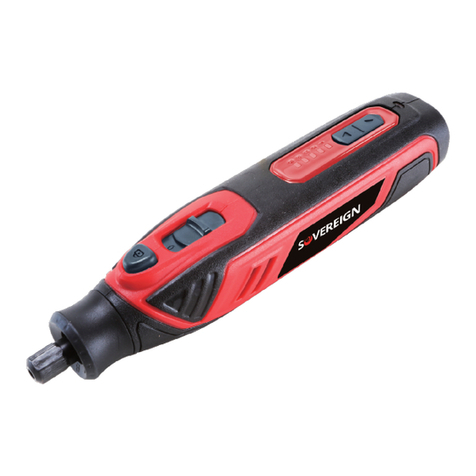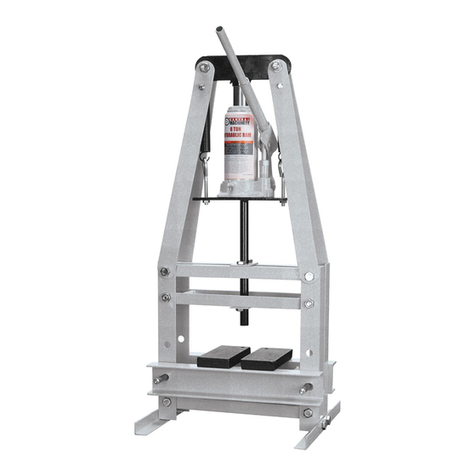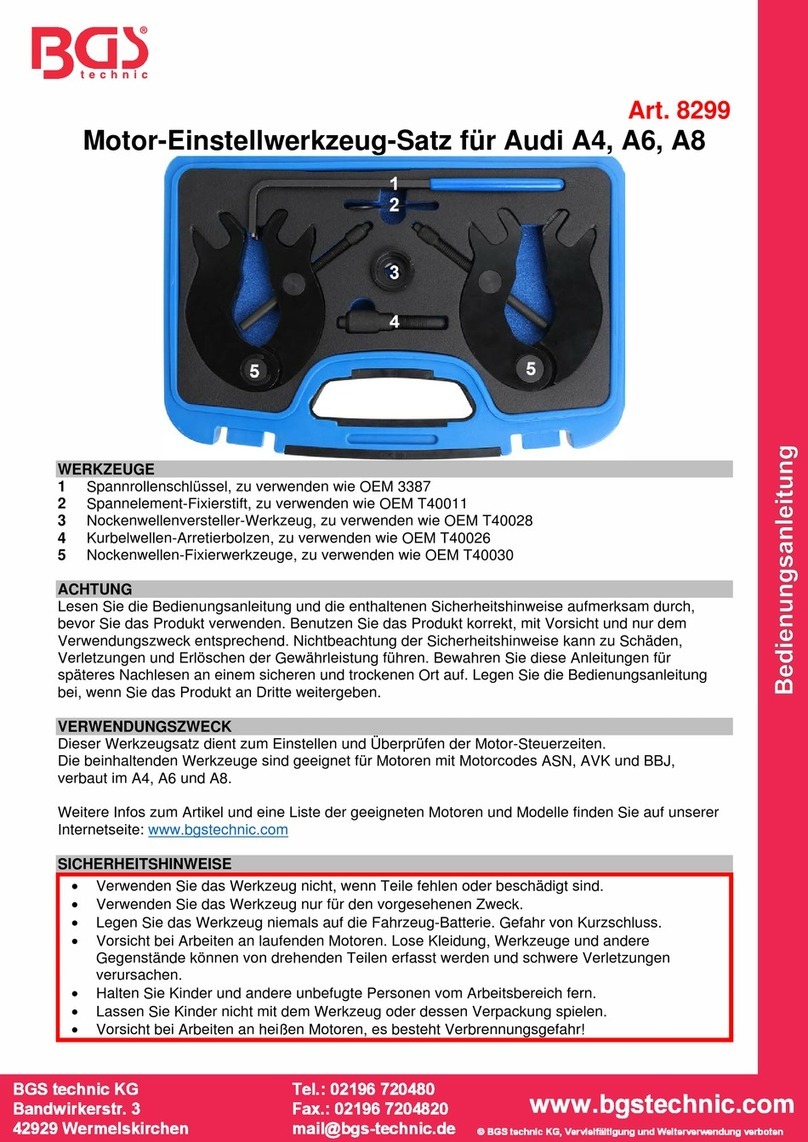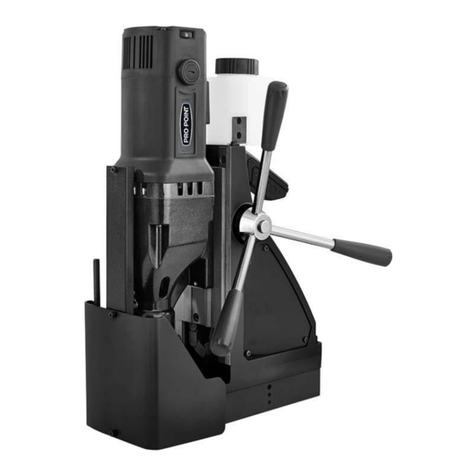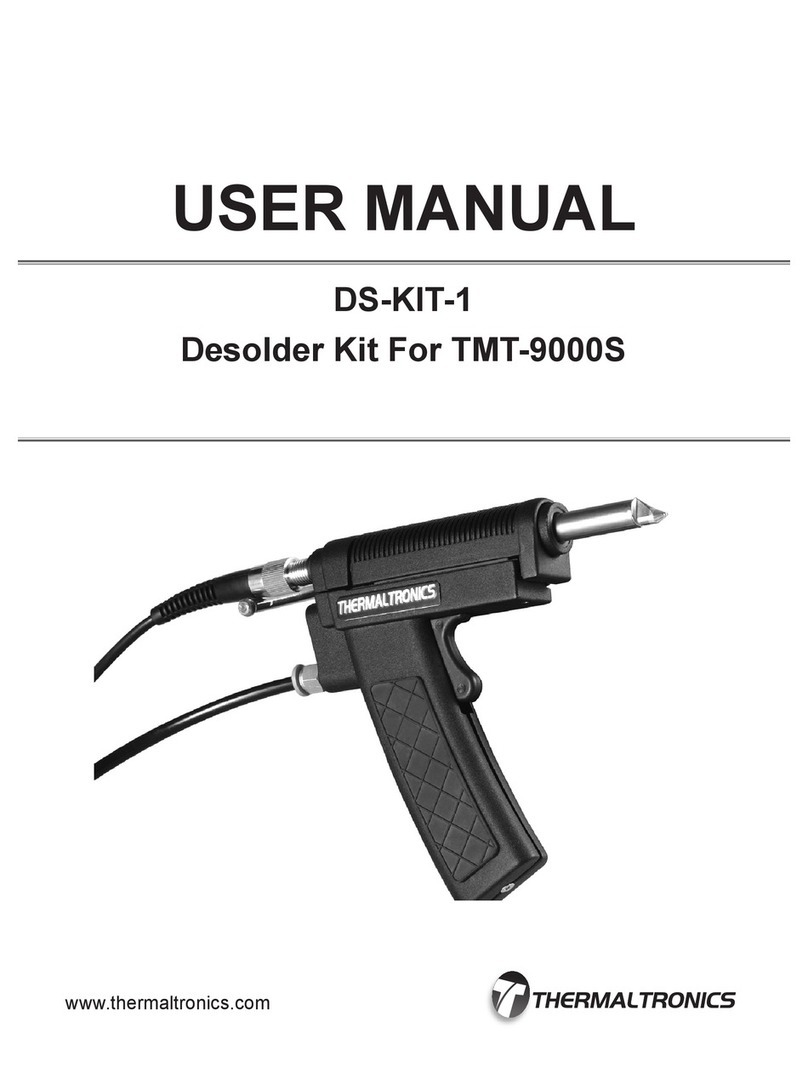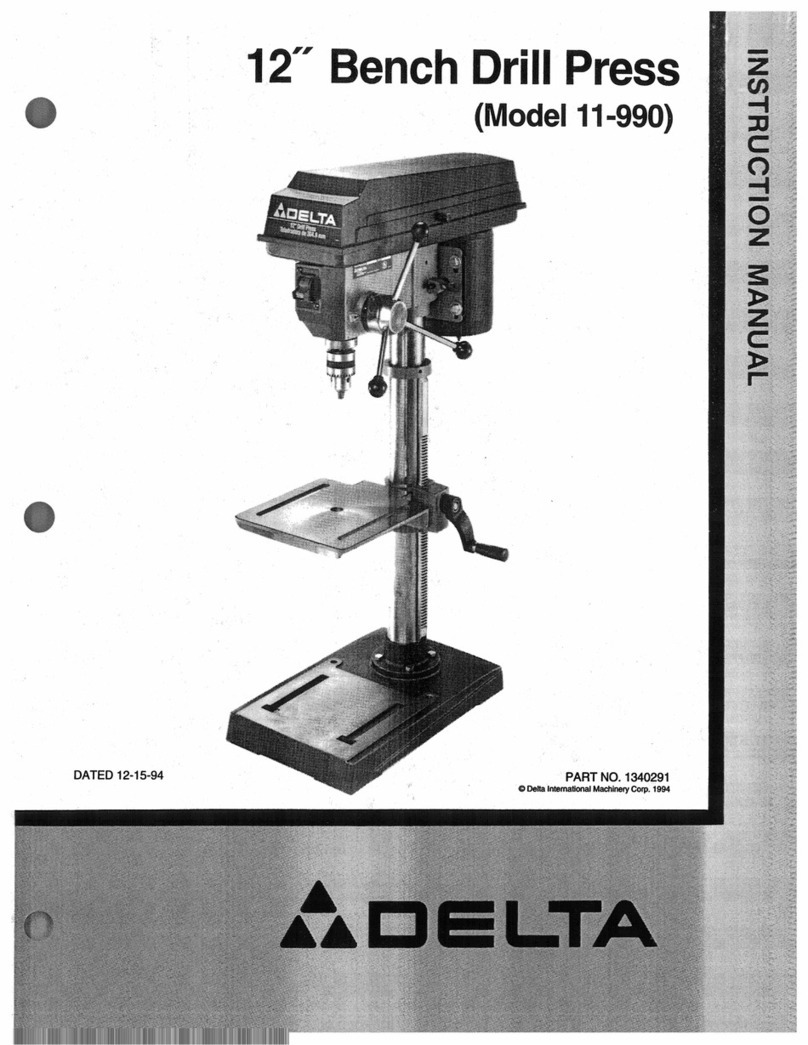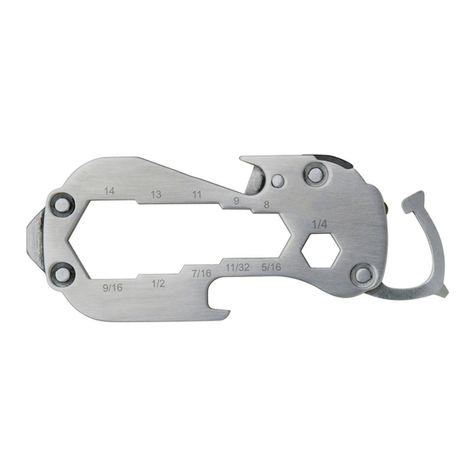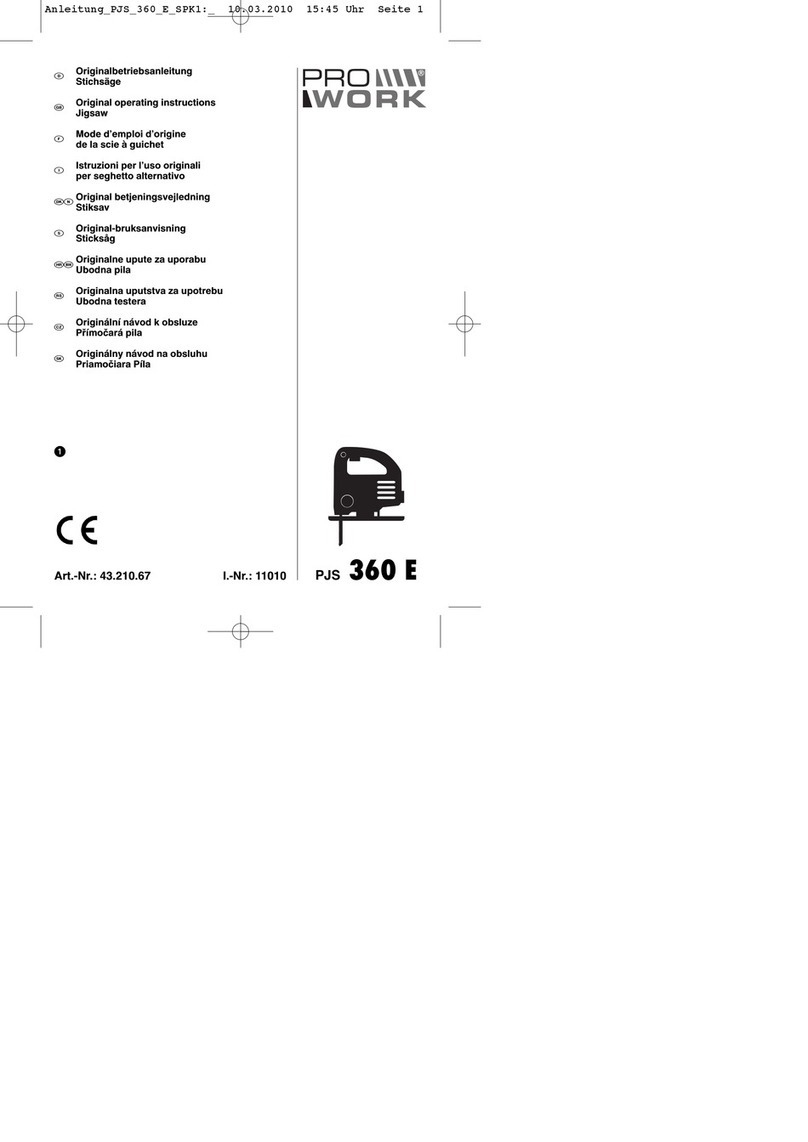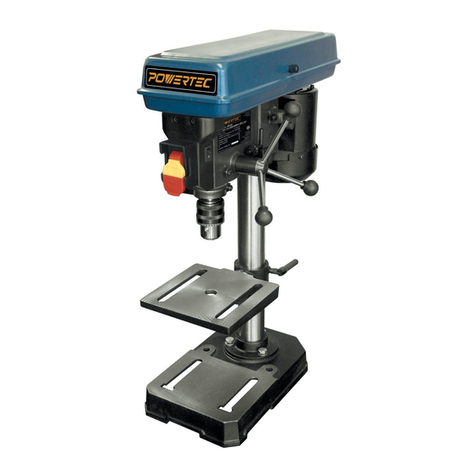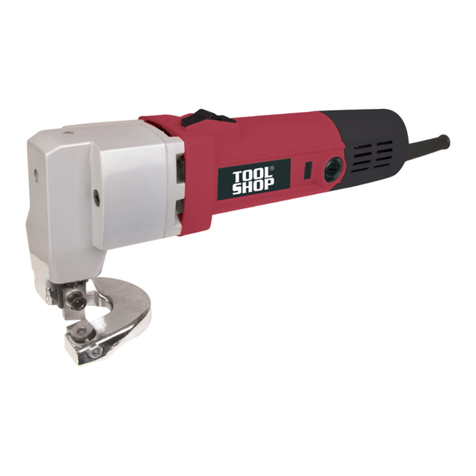Sovereign DM-130B-1 User guide

135W ROTARY TOOL SET
Item No. 594448
Model No. DM-130B-1
HHGL Limited, MK9 1BA; HHGL (ROI) Limited, D02 X576 Mar 21
ORIGINAL INSTRUCTION MANUAL
Please read these instructions fully before starting assembly.
www.coreservice.co.uk
Technical Support & Parts
01904 727509
Mon-Fri 9am-5pm Sat-Sun 11am-4pm

2
CONTENTS
Contents 2
General safety warnings 3
Warning symbols 16
In the box 17
Operation 18
Maintenance and storage 24
Technical data 25
Recycling and disposal 27
UK plug 27
Getting help 28
Warranty 28

3
GENERAL SAFETY INFORMATION
WARNING! Read all safety warnings,
provided with this power tool.
Failure to follow all instructions listed below
injury.
Save all warnings and instructions for future
reference.
The term "power tool" in the warnings refers to your
mains-operated (corded) power tool or battery-
operated (cordless) power tool.
1) Work area safety
a. Keep work area clean and well lit. Cluttered or
dark areas invite accidents.
b. Do not operate power tools in explosive
atmospheres, such as in the presence of
flammable liquids, gases or dust. Power tools
create sparks which may ignite the dust or fumes.
c. Keep children and bystanders away while
operating a power tool. Distractions can cause
you to lose control.
2) Electrical safety
a. Power tool plugs must match the outlet. Never
modify the plug in any way. Do not use any
adaptor plugs with earthed (grounded) power

4
tools. Unmodified plugs and matching outlets will
reduce risk of electric shock.
b. Avoid body contact with earthed or grounded
surfaces, such as pipes, radiators, ranges and
refrigerators. There is an increased risk of electric
shock if your body is earthed or grounded.
c. Do not expose power tools to rain or wet
conditions. Water entering a power tool will
increase the risk of electric shock.
d. Do not abuse the cord. Never use the cord for
carrying, pulling or unplugging the power tool.
Keep cord away from heat, oil, sharp edges
or moving parts. Damaged or entangled cords
increase the risk of electric shock.
e. When operating a power tool outdoors, use an
extension cord suitable for outdoor use. Use of
a cord suitable for outdoor use reduces the risk of
electric shock.
f. If operating a power tool in a damp location
is unavoidable, use a residual current device
(RCD) protected supply. Use of an RCD reduces
the risk of electric shock.
3) Personal safety
a. Stay alert, watch what you are doing and
use common sense when operating a power
tool. Do not use a power tool while you are
tired or under the influence of drugs, alcohol

5
or medication. A moment of inattention while
operating power tools may result in serious
personal injury.
b. Use personal protective equipment. Always
wear eye protection. Protective equipment such
as dust mask, non-skid safety shoes, hard hat, or
hearing protection used for appropriate conditions
will reduce personal injuries.
c. Prevent unintentional starting. Ensure the
switch is in the 'off' position before connecting
to power source and/or battery pack, picking
up or carrying the tool. Carrying power tools
with your finger on the switch or energising power
tools that have the switch on invites accidents.
d. Remove any adjusting key or wrench before
turning the power tool on. A wrench or a key left
attached to a rotating part of the power tool may
result in personal injury.
e. Do not overreach. Keep proper footing and
balance at all times. This enables better control
of the power tool in unexpected situations.
f. Dress properly. Do not wear loose clothing or
jewellery. Keep your hair, clothing and gloves
away from moving parts. Loose clothes, jewellery
or long hair can be caught in moving parts.
g. If devices are provided for the connection of
dust extraction and collection facilities, ensure
these are connected and properly used. Use of
these devices can reduce dust-related hazards.

6
h. Do not let familiarity gained from frequent use
of tools allow you to become complacent and
ignore tool safety principles. A careless action
can cause severe injury within a fraction of a
second.
4) Power tool use and care
a. Do not force the power tool. Use the correct
power tool for your application. The correct
power tool will do the job better and safer at the
rate for which it was designed.
b. Do not use the power tool if the switch does
not turn it on and off. Any power tool that cannot
be controlled with the switch is dangerous and
must be repaired.
c. Disconnect the plug from the power source
and/or the battery pack from the power tool
before making any adjustments, changing
accessories, or storing power tools. Such
preventive safety measures reduce the risk of
starting the power tool accidentally.
d. Store idle power tools out of the reach of
children and do not allow persons unfamiliar
with the power tool or these instructions
to operate the power tool. Power tools are
dangerous in the hands of untrained users.
e. Maintain power tools. Check for misalignment
or binding of moving parts, breakage of parts
and any other condition that may affect the
power tools operation. If damaged, have the

7
power tool repaired before use. Many accidents
are caused by poorly maintained power tools.
f. Keep cutting tools sharp and clean. Properly
maintained cutting tools with sharp cutting edges
are less likely to bind and are easier to control.
g. Use the power tool, accessories and tool bits,
etc., in accordance with these instructions,
taking into account the working conditions and
the work to be performed. Use of the power tool
for operations different from those intended could
result in a hazardous situation.
h. Keep handles and gripping surfaces dry, clean
and free from oil and grease. Slippery handles
and gripping surfaces do not allow for safe
handling and control of the tool in unexpected
situations.
Service
a) Have your power tool serviced by a qualified
repair person using only identical replacement
parts. This will ensure that the safety of the power
tool is maintained.

8
SAFETY INSTRUCTIONS FOR ALL OPERATIONS
Safety Warnings common for grinding, sanding,
wire brushing, polishing, carving or abrasive
cutting-off operations:
a) This power tool is intended to function as a
grinder, sander, wire brush, polisher, carver or
cut-off tool. Read all safety warnings, instructions,
illustrations and specifications provided with this
power tool. Failure to follow all instructions listed
injury.
b) Operations such as polishing is not
recommended to be performed with this power
tool. Operations for which the power tool was not
designed may create a hazard and cause personal
injury.
c) Do not use accessories which are not
specifically designed and recommended by the
tool manufacturer. Just because the accessory can
be attached to your power tool, it does not assure
safe operation.
d) The rated speed of the grinding accessories
must be at least equal to the maximum speed
marked on the power tool. Grinding accessories
running faster than their rated speed can break and
fly apart.
e) The outside diameter and the thickness of your
accessory must be within the capacity rating
of your power tool. Incorrectly sized accessories
cannot be adequately controlled.

9
f) The arbour size of wheels, sanding drums or
any other accessory must properly fit the spindle
or collet of the power tool. Accessories that do not
match the mounting hardware of the power tool will
run out of balance, vibrate excessively and may cause
loss of control.
g) Mandrel mounted wheels, sanding drums,
cutters or other accessories must be fully
inserted into the collet or chuck. If the mandrel is
is too long, the mounted wheel may become loose
and be ejected at high velocity.
h) Do not use a damaged accessory. Before each
use, inspect the accessory, such as abrasive
wheels for chips and cracks, sanding drum for
cracks, tear or excess wear, wire brush for loose
or cracked wires. If the power tool or accessory
is dropped, inspect for damage or install an
undamaged accessory. After inspecting and
installing an accessory, position yourself and
bystanders away from the plane of the rotating
accessory and run the power tool at maximum no-
load speed for one minute. Damaged accessories
will normally break apart during this test time.
i) Wear personal protective equipment.
Depending on application, use a face shield,
safety goggles or safety glasses. As appropriate,
wear a dust mask, hearing protectors, gloves
and workshop apron capable of stopping small
abrasive or workpiece fragments. The eye
protection must be capable of stopping flying debris

10
generated by various operations. The dust mask
or respirator must be capable of filtrating particles
generated by your operation. Prolonged exposure to
high intensity noise may cause hearing loss.
j) Keep bystanders a safe distance away from the
work area. Anyone entering the work area must
wearpersonal protective equipment. Fragments of
workpiece or of a broken accessory may fly out and
cause injury beyond immediate area of operation.
k) Hold the power tool by insulated gripping
surfaces only, when performing an operation
where the cutting accessory may contact hidden
wiring or its own cord. Cutting accessory contacting
a “live” wire may make exposed metal parts of the
power tool “live” and could give the operator an
electric shock.
l) Always hold the tool firmly in your hand(s)
during the start up. The reaction torque of the
motor, as it accelerates to full speed, can cause the
tool to twist.
m) Use clamps to support the workpiece
whenever practical. Never hold a small workpiece
in one hand and the tool in the other hand while
in use. Clamping a small workpiece allows you to use
your hand(s) to control the tool. Round material, such
as dowel rods, pipes or tubing, have a tendency to
roll while being cut, and may cause the bit to bind or
jump toward you.

11
n) Position the cord clear of the spinning
accessory. If you lose control, the cord may be cut
or snagged and your hand or arm may be pulled into
the spinning accessory.
o) Never lay the power tool down until the
accessory has come to a complete stop. The
spinning accessory may grab the surface and pull the
power tool out of your control.
p) After changing the bits or making any
adjustments, make sure the collet nut, chuck
or any other adjustment devices are securely
tightened. Loose adjustment devices can
unexpectedly shift, causing loss of control; loose
rotating components will be violently thrown.
q) Do not run the power tool while carrying it
at your side. Accidental contact with the spinning
accessory could snag your clothing, pulling the
accessory into your body.
r) Regularly clean the power tools air vents. The
motors fan will draw the dust inside the housing
and excessive accumulation of powdered metal may
cause electrical hazards.
s) Do not operate the power tool near flammable
materials. Sparks could ignite these materials.
t) Do not use accessories that require liquid
coolants. Using water or other liquid coolants may
result in electrocution or shock.

12
Further safety instructions for all operations
Kickback and related warnings
Kickback is a sudden reaction to a pinched or
snagged rotating wheel, sanding band, brush or any
other accessory. Pinching or snagging causes rapid
stalling of the rotating accessory which in turn causes
the uncontrolled power tool to be forced in the
direction opposite of the accessory’s rotation.
For example, if an abrasive wheel is snagged or
pinched by the workpiece, the edge of the wheel
that is entering into the pinch point can dig into the
surface of the material, causing the wheel to climb
out or kick out. The wheel may either jump toward or
away from the operator, depending on the direction
of the wheels movement at the point of pinching.
Abrasive wheels may also break under these
conditions.
incorrect operating procedures or conditions and
can be avoided by taking proper precautions as given
below.
a) Maintain a firm grip on the power tool and
position your body and arm to allow you to resist
kickback forces. The operator can control kickback
forces, if proper precautions are taken.
b) Use special care when working corners, sharp
edges, etc. Avoid bouncing and snagging the
accessory. Corners, sharp edges or bouncing have
a tendency to snag the rotating accessory and cause
loss of control or kickback.

13
c) Do not attach a toothed saw blade. Such blades
create frequent kickback and loss of control.
d) Always feed the bit into the material in the
same direction as the cutting edge is exiting from
the material (which is the same direction as the
chips are thrown). Feeding the tool in the wrong
direction causes the cutting edge of the bit to climb
out of the work and pull the tool in the direction of
this feed.
e) When using rotary files, cut-off wheels, high-
speed cutters or tungsten carbide cutters, always
have the work securely clamped. These wheels will
grab if they become slightly canted in the groove, and
can kick back. When a cut-off wheel grabs, the wheel
itself usually breaks. When a rotary file, high-speed
cutter or tungsten carbide cutter grabs, it may jump
from the groove and you could lose control of the
tool.
Safety Warnings Specific for Grinding and
Abrasive Cutting-Off Operations:
a) Use only wheel types that are recommended
for your power tool and only for recommended
applications. For example: do not grind with the
side of a cut-off wheel. Abrasive cut-off wheels are
intended for peripheral grinding, side forces applied
to these wheels may cause them to shatter.
b) For threaded abrasive cones and plugs,
use only undamaged wheel mandrels with an

14
unrelieved shoulder flange that are of correct
size and length. Proper mandrels will reduce the
possibility of breakage.
c) Do not “jam” a cut-off wheel or apply excessive
pressure. Do not attempt to make an excessive
depth of cut. Overstressing the wheel increases the
loading and susceptibility to twisting or snagging of
the wheel in the cut and the possibility of kickback or
wheel breakage.
d) Do not position your hand in line with or
behind the rotating wheel. When the wheel, at the
point of operation, is moving away from your hand,
the possible kickback may propel the spinning wheel
and the power tool directly at you.
e) When the wheel is pinched, snagged or when
interrupting a cut for any reason, switch off the
power tool and hold the power tool motionless
until the wheel comes to a complete stop. Never
attempt to remove the cut-off wheel from the cut
while the wheel is in motion, otherwise kickback
may occur. Investigate and take corrective action to
eliminate the cause of wheel pinching or snagging.
f) Do not restart the cutting operation in the
workpiece. Let the wheel reach full speed and
carefully re-enter the cut. The wheel may bind,
walk up or kickback if the power tool is restarted in
the workpiece.
g) Support panels or any oversized workpiece to
minimise the risk of wheel pinching and kickback.
Large workpieces tend to sagunder their own weight.
Supports must be placed under the workpiece near

15
the line of cut and near the edge of the workpiece on
both sides of the wheel.
h) Use extra caution when making a “pocket
cut” into existing walls or other blind areas.
The protruding wheel may cut gas or water pipes,
electrical wiring or objects that can cause kickback.
Safety Warnings Specific for Wire Brushing
Operations:
a) Be aware that wire bristles are thrown by the
brush even during ordinary operation. Do not
overstress the wires by applying excessive load to
the brush. The wire bristles can easily penetrate light
b) Allow brushes to run at operating speed for at
least one minute before using them. During this
time, no one is to stand in front or in line with
the brush. Loose bristles or wires will be discharged
during the run-in time.
c) Direct the discharge of the spinning wire
brush away from you. Small particles and tiny wire
fragments may be discharged at high velocity during
the use of these brushes and may become imbedded
in your skin.

16
WARNING SYMBOLS
Warning!
Read the instructions
Wear ear protection
Wear eye protection
Wear a dust mask
Class II tool
The product complies with the applicable European
directives, and an evaluation method of conformity
for these directives was done.
Recycle unwanted materials instead of disposing
of them as household waste. All tools, hoses
and packaging should be sorted, taken to the
local recycling centre and disposed of in an
environmentally safe way.
The product complies with the applicable UK
directives, and an evaluation method of conformity
for these directives was followed.

17
IN THE BOX
Description
1. Collet nut
2. Spindle lock button
3. Carbon brush holder
(on both sides)
4. Speed selector
5. Hook
6.
7. Spanner
8. Flexible shaft
Accessories
10pcs Grinding wheel with shank
2pcs Diamond bits
4pcs Sanding drum
1pc Sanding shank
2pcs Drill bits
2pcs Mandrel
4pcs Felt wheel
8pcs Cutting disk
3pcs Sanding paper
2pcs Collets (3.2mm & 2.3mm)
1pc Spanner
1pc Whet stone
1pc Flexible shaft

18
OPERATION
NOTE: Before using the tool, read the
instruction book carefully.
Intended Use
This tool is intended for grinding and polishing metal, as well
as for cutting metal and drilling into metal and wood.
1. CHANGE THE COLLET (SEE FIG. A)
Two sizes (3.2mm pre-assembled, 2.3mm as an accessory) of
collets are provided to accommodate the different accessories
shank sizes.
When using an accessory with a smaller or larger shaft, you
will need to change the collet which matches the shank size of
the accessory, as follows:
Press the spindle lock button. Loosen the collet nut (1) with
the spanner provided. Remove the collet nut (1) and then fully
insert the appropriate size collet into the spindle.
Reinstall the collet nut (1) finger tight. Do not over-tighten the
nut when there is no accessory in the collet.
WARNING! Fully tighten the collet nut before
operation. Always use the collet which matches the
shank size of the accessory you plan to use. Do not
force a larger diameter shank into a smaller collet.

19
2. FITTING AN ACCESSORY (SEE FIG. B, C)
Press the spindle lock button. Hold down and rotate the
spindle by hand until the spindle lock engages with the
spindle. Loosen the collet nut anti-clockwise using the spanner
if necessary.
Fully insert the tool shank into the collet. Tighten the collet nut
with the spanner but do not over-tighten. Finally release the
spindle lock button.
WARNING! Do not engage the spindle lock button
while the tool is running.
3. FITTING A CUTTING/SANDING WHEEL (SEE FIG. D, E)
First, fit the cutting wheel fixture into the collet. Loosen the
small screw (a) on the cutting wheel fixture with the top of the
collet spanner. Insert the screw through the cutting wheel and
then screw into the cutting wheel fixture. Do not over-tighten,
otherwise the wheel may crack.

20
4. ASSEMBLING THE FELT WHEEL (SEE FIG. F)
The felt wheel is used with the mandrel. Thread the wheel on
to the screw carefully.
The felt wheel must thread down straight on the mandrel, and
be turned all the way to the collar.
5. FITTING THE SANDING ROLL (SEE FIG. G1, G2, G3)
To fit the sanding roll, firstly loosen the small screw on top
of the hole for the rubber wheel, this will allow the rubber to
relax. Slide the sanding roll onto the holder.
To secure, simply tighten the screw and the rubber roll will
swell, gripping the sanding drum.
This manual suits for next models
1
Table of contents
Other Sovereign Power Tools manuals
